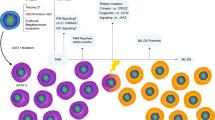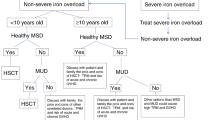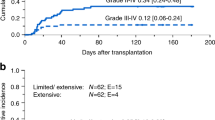Abstract
Fanconi anaemia (FA) is a rare genetic disease characterized by chromosomal instability, somatic abnormalities, marrow failure and cancer proness. The main cause of morbidity and mortality is bone marrow failure, which typically arises in the first decade of life and progresses to full-blown transfusion dependence and severe neutropenia in a variable number of years. Myelodysplastic syndrome (MDS) and AML may arise on the background of marrow failure, although cases of patients diagnosed with MDS or overt leukaemia before the full appearance of marrow aplasia are reported. This article reviews the current options for treatment of bone marrow failure in FA and provides an algorithm for supporting decisions on treatment. The use of androgens, corticosteroids and growth factors is reviewed, as well as the results in recent cohorts of matched sibling donor haematopoietic stem cell (HSC) transplants and unrelated donor HSC transplants, including cord blood graft. The conditioning regimens used are analysed and commented. Up-to-date information on second tumours after HSC transplant and on experimental treatments such as gene therapy, prenatal and preimplantation diagnosis and inhibition of pro-inflammatory cytokines is provided.
This is a preview of subscription content, access via your institution
Access options
Subscribe to this journal
Receive 12 print issues and online access
$259.00 per year
only $21.58 per issue
Buy this article
- Purchase on Springer Link
- Instant access to full article PDF
Prices may be subject to local taxes which are calculated during checkout

Similar content being viewed by others
References
Faivre L, Guardiola P, Lewis C, Dokal I, Ebell W, Zatterale A et al. Association of complementation group and mutation type with clinical outcome in Fanconi anemia. European Fanconi Anemia Research Group. Blood 2000; 96: 4064–4070.
Levitus M, Rooimans MA, Steltenpool J, Cool NF, Oostra AB, Mathew CG et al. Heterogeneity in Fanconi anemia: evidence for 2 new genetic subtypes. Blood 2004; 103: 2498–2503.
Bagby GC, Alter BP . Fanconi anemia. Semin Hematol 2006; 43: 147–156.
Dufour C, Corcione A, Svahn J, Haupt R, Poggi V, Beka'ssy AN et al. TNF-alpha and IFN-gamma are overexpressed in the bone marrow of Fanconi anemia patients and TNF-alpha suppresses erythropoiesis in vitro. Blood 2003; 102: 2053–2059.
Sejas DP, Rani R, Qiu Y, Zhang X, Fagerlie SR, Nakano H et al. Inflammatory reactive oxygen species-mediated hemopoietic suppression in Fancc-deficient mice. J Immunol 2007; 178: 5277–5287.
Zhang X, Sejas DP, Qiu Y, Williams DA, Pang Q . Inflammatory ROS promote and cooperate with the Fanconi anemia mutation for hematopoietic senescence. J Cell Sci 2007; 120: 1572–1583.
Alter BP . Inherited bone marrow failure syndromes. In: Nathan DG, Orkin SH, Ginsburg D, Look AT (eds). Haematology of Infancy and Childhood, 6th edn. WB Saunders Company: Philadelphia, PA, 2003, pp 280–365.
Guardiola P, Pasquini R, Dokal I, Ortega JJ, van Weel-Sipman M, Marsh JC et al. Outcome of 69 allogeneic stem cell transplantations for Fanconi anemia using HLA-matched unrelated donors: a study on behalf of the European Group for Blood and Marrow Transplantation. Blood 2000; 95: 422–429.
de Medeiros CR, Bitencourt MA, Zanis-Neto J, Maluf EC, Carvalho DS, Bonfim CS et al. Allogeneic hematopoietic stem cell transplantation from an alternative stem cell source in Fanconi anemia patients: analysis of 47 patients from a single institution. Braz J Med Biol Res 2006; 39: 1297–1304.
Gluckman E, Auerbach AD, Horowitz MM, Sobocinski KA, Ash RC, Bortin MM et al. Bone marrow transplantation for Fanconi anemia. Blood 1995; 86: 2856–2862.
Zanis-Neto J, Flowers ME, Medeiros CR, Bitencourt MA, Bonfim CM, Setubal DC et al. Low-dose cyclophosphamide conditioning for haematopoietic cell transplantation from HLA-matched related donors in patients with Fanconi anaemia. Br J Haematol 2005; 130: 99–106.
Dufour C, Rondelli R, Locatelli F, Miano M, Di Girolamo G, Bacigalupo A et al. Stem cell transplantation from HLA-matched related donor for Fanconi's anaemia: a retrospective review of the multicentric Italian experience on behalf of AIEOP-GITMO. Br J Haematol 2001; 112: 796–805.
Farzin A, Davies SM, Smith FO, Filipovich A, Hansen M, Auerbach AD et al. Matched sibling donor haematopoietic stem cell transplantation in Fanconi anaemia: an update of the Cincinnati Children's experience. Br J Haematol 2007; 136: 633–640.
Tan PL, Wagner JE, Auerbach AD, Defor TE, Slungaard A, Macmillan ML . Successful engraftment without radiation after fludarabine-based regimen in Fanconi anemia patients undergoing genotypically identical donor hematopoietic cell transplantation. Pediatr Blood Cancer 2006; 46: 630–636.
Socie G, Devergie A, Girinski T, Piel G, Ribaud P, Esperou H et al. Transplantation for Fanconi's anaemia: long-term follow-up of fifty patients transplanted from a sibling donor after low-dose cyclophosphamide and thoraco-abdominal irradiation for conditioning. Br J Haematol 1998; 103: 249–255.
Rosenberg PS, Socie G, Alter BP, Gluckman E . Risk of head and neck squamous cell cancer and death in patients with Fanconi anemia who did and did not receive transplants. Blood 2005; 105: 67–73.
Wagner JE, Eapen N, Mc Millan ML, Harris RE, Pasquini R, Boulad F et al. Unrelated donor bone marrow transplantation for the treatment of Fanconi anemia. Blood 2007; 109: 2256–2262.
Yabe H, Inoue H, Matsumoto M, Hamanoue S, Koike T, Ishiguro H et al. Allogeneic haematopoietic cell transplantation from alternative donors with a conditioning regimen of low-dose irradiation, fludarabine and cyclophosphamide in Fanconi anaemia. Br J Haematol 2006; 134: 208–212.
Deeg HJ, Socie G, Schoch G, Henry-Amar M, Witherspoon RP, Devergie A et al. Malignancies after marrow transplantation for aplastic anemia and Fanconi anemia: a joint Seattle and Paris analysis of results in 700 patients. Blood 1996; 87: 386–392.
Kelly PF, Radtke S, Kalle C, Balcik B, Bohn K, Mueller R et al. Stem cell collection and gene transfer in Fanconi anemia. Mol Ther 2007; 15: 211–219.
Jacome A, Navarro S, Casado JA, Rio P, Madero L, Estella J et al. A simplified approach to improve the efficiency and safety of ex vivo hematopoietic gene therapy in Fanconi anemia patients. Hum Gene Ther 2006; 17: 245–250.
Yamada K, Ramezani A, Hawley RG, Ebell W, Arwert F, Arnold LW et al. Phenotype correction of Fanconi anemia group A hematopoietic stem cells using lentiviral vector. Mol Ther 2003; 8: 600–610.
Grewall SS, Kahn JP, Mc Millan ML, Ramsay NK, Wagner JE . Successful hematopoietic stem cell transplantation for Fanconi anemia from an unaffected HLA-genotype-identical sibling selected using preimplantation genetic diagnosis. Blood 2004; 103: 1147–1151.
Acknowledgements
Compagnia di San Paolo, ERG s.p.a, Fondazione Banca Popolare di Novara are acknowledged for supporting the activity of the Haematology Unit of the G Gaslini Children's Hospital.
Author information
Authors and Affiliations
Corresponding author
Additional information
Conflict of interest
Neither author declared any financial interests.
Rights and permissions
About this article
Cite this article
Dufour, C., Svahn, J. Fanconi anaemia: new strategies. Bone Marrow Transplant 41 (Suppl 2), S90–S95 (2008). https://doi.org/10.1038/bmt.2008.63
Published:
Issue Date:
DOI: https://doi.org/10.1038/bmt.2008.63
Keywords
This article is cited by
-
SAMD9 and SAMD9L in inherited predisposition to ataxia, pancytopenia, and myeloid malignancies
Leukemia (2018)
-
Cellular response to DNA interstrand crosslinks: the Fanconi anemia pathway
Cellular and Molecular Life Sciences (2016)
-
Increased apoptosis is linked to severe acute GVHD in patients with Fanconi anemia
Bone Marrow Transplantation (2013)
-
Current and emerging therapeutic strategies for Fanconi anemia
The HUGO Journal (2012)



